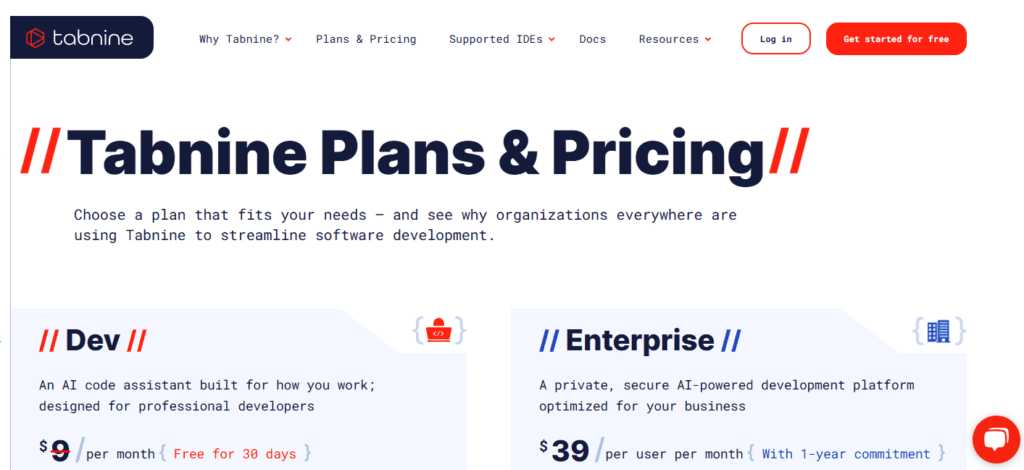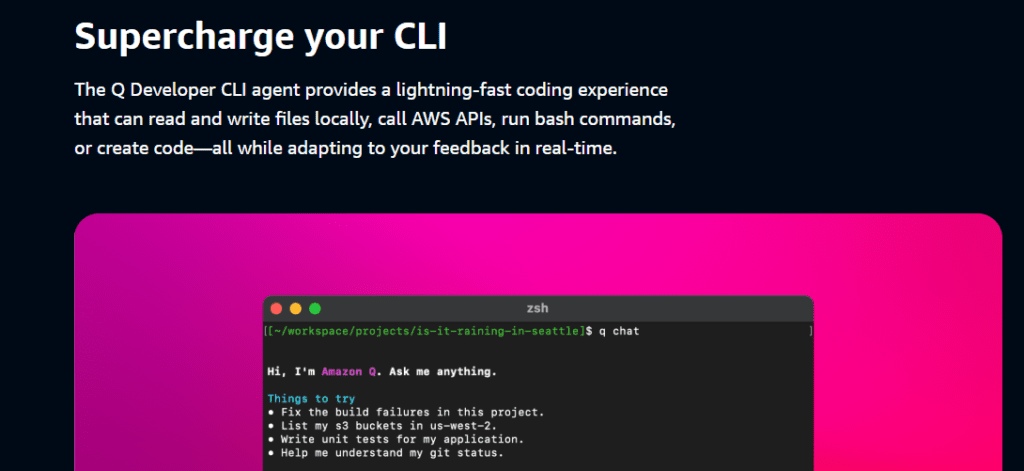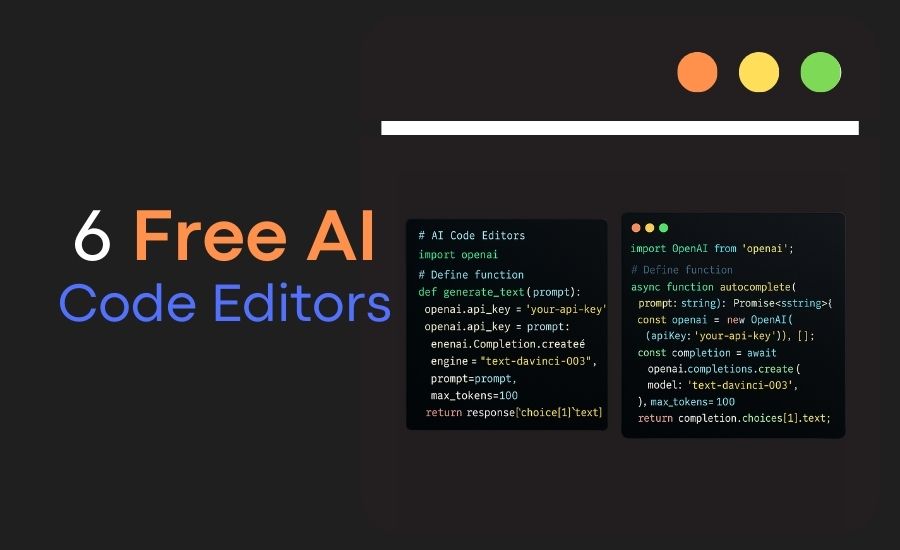AI code editors are modern development tools that go beyond just highlighting syntax or auto-closing brackets. They use artificial intelligence to actually understand the context of your code, which is what really sets them apart from traditional editors.
Table of Contents
While a regular code editor might help you write faster with basic autocomplete, an AI-powered editor can suggest entire lines or functions based on what you’re trying to build. It can catch potential bugs before you even run the code, explain what a complex function does, and even help you write documentation, all in real time.
So, how exactly are they different?
| Feature | Traditional Code Editors | AI Code Editors |
| Syntax Highlighting | ✅ | ✅ |
| Code Autocomplete | ✅ (basic) | ✅ (context-aware, smarter) |
| Real-time Error Detection | ❌ | ✅ |
| Code Explanation | ❌ | ✅ |
| Auto-Documentation | ❌ | ✅ |
| Natural Language Prompts | ❌ | ✅ |
To sum it up, AI code editors are more than just tools for writing code. They act like intelligent assistants that support you as you work, helping you save time, reduce errors, and stay focused on what actually matters – building great software.
Why AI-Enhanced Coding Matters Today

As projects grow and deadlines shrink, developers need more than just a good editor. They need tools that actively help them stay efficient and focused.
That’s where AI-enhanced code editors come in. They take care of the repetitive parts, suggest useful snippets based on what you’re building, and even flag bugs while you’re still typing. Instead of wasting time on boilerplate code or fixing typos later, you get to spend more time actually solving problems.
Another big win is how much they reduce context switching. Rather than jumping between your IDE, documentation, and search results, the AI can handle explanations, code suggestions, and even quick fixes right inside the editor.
For solo devs, this feels like having a smart coding partner. For teams, it leads to fewer bugs, quicker reviews, and a smoother development cycle.
In short, AI coding tools aren’t just trendy. They’re becoming a serious productivity advantage.
All the tools we’re about to cover are either completely free to use or come with a generous free tier. That means you can start experimenting, building, and testing without needing to pull out your credit card. Whether you’re a student, a freelancer, or part of a dev team, these editors give you serious capabilities without the upfront cost.
How We Chose These Top 6 AI Code Editors
Why 6 and why not 10? because this list isn’t just a random collection of tools. Each editor featured here was picked based on a few key factors that actually matter to developers.
We looked at core features like AI code suggestions, real-time error detection, and how well the tools integrate into existing workflows. Community trust and adoption played a big role too, if thousands of developers rely on it daily, that’s a good sign. Compatibility with major programming languages, platforms, and version control systems also made a difference.
I hate wasting time on shiny features that don’t actually help me code. That’s why I zeroed in on what actually matters – real-world usefulness. These editors aren’t just fancy spec sheets or marketing hype. They’re the tools that have genuinely saved me hours of frustration and helped me ship better code on tighter deadlines.
What Types of Tools Are Included?
This list includes a mix of desktop IDEs, browser-based editors, and AI plugins that enhance popular editors like VS Code. The goal is to highlight useful options for all kinds of developers, whether you’re coding locally on your machine, working in the cloud, or just looking to upgrade your existing setup with smarter features.
So whether you prefer lightweight browser tools or full-featured environments, there’s something here for you.
Here is the list of top 6 free AI code editors
Here’s a breakdown of the best AI code editors and tools available right now. All of them are free or offer solid free tiers, and they’ve been selected based on features, community trust, and real-world usefulness.
1. GitHub Copilot

Github Copilot changed everything for my workflow. Started using it last year when my team lead wouldn’t shut up about it. Took me a week to get used to, but now coding without it feels like typing with mittens on. The GitHub/OpenAI collab actually delivers – I mumble something about “parsing JSON from that API” and BOOM, usable code appears. Not perfect, but saves me from googling the same damn syntax for the 500th time. Worth every penny of my boss’s money lol.
Key Features
- Writes entire lines or functions with just a few words from you
- Understands your code context and offers smart suggestions
- Can turn comments into working code
- Helps with cleanup and simple refactoring along the way
Platforms & Language Support
Copilot integrates directly with popular editors like VS Code, JetBrains, and Neovim.
It works with dozens of languages, including JavaScript, Python, Go, Ruby, and TypeScript.
Free Plan Details
If you’re a verified student or an open-source contributor, Copilot is completely free. Otherwise, there’s a 30-day free trial to get a feel for how it fits into your workflow.
Pros
- Incredibly helpful for repetitive tasks and boilerplate code
- Integrates well into existing IDEs without extra effort
- Strong community support and frequent updates
Cons
- Struggles with complex logic or architecture decisions
- Can occasionally suggest outdated or insecure patterns
- Sends usage data to improve suggestions unless disabled
Best For: Developers who live in VS Code or JetBrains, especially students, frontend/backend devs, or solo builders who want to move fast without writing every single line from scratch.
2. Windsurf (formerly Codeium)

Windsurf is a fast, lightweight AI coding assistant built to feel like a hidden superpower inside your favorite editor. It stands out by offering full access to advanced autocomplete features, completely free for individual developers.
Key Features
- Smart, real-time code completions as you type
- Converts plain English into working code snippets
- Explains existing code to help you understand it better
- Works with a wide range of programming languages and file types
Platforms & Language Support
- Compatible with VS Code, JetBrains, Vim, Jupyter, and browser-based IDEs
- Supports 70+ programming languages including Python, JavaScript, C++, PHP, Java, and more
Free Plan Details
- 100% free for individual use
- No token limits, usage caps, or paywalls – just install and start coding
Pros
- Totally free for personal use
- Incredibly fast and responsive autocomplete
- Broad language and editor support
Cons
- Minimal UI – lacks chat or documentation features found in some alternatives
- Still growing and lesser known compared to GitHub Copilot
Best For: Solo developers, students, or anyone looking for a powerful AI coding assistant without spending a dime. Great for everyday coding, learning new languages, or speeding up repetitive work.
3. Cursor

Cursor is a new kind of code editor built from the ground up to work with AI. It takes the best parts of VS Code, adds AI as a first-class feature, and gives you a development environment where asking questions and getting help feels like part of the workflow.
Key Features
- Highlights code and lets you ask questions directly inside the editor
- Offers real-time autocomplete and bug fixes
- Can rewrite or explain selected code with one click
- Feels like coding with a built-in assistant who actually knows your project
Platforms & Language Support
Cursor is its own standalone desktop app based on VS Code, so it feels familiar if you’re coming from there.
It supports all major languages that VS Code does, including Python, JavaScript, Go, Rust, TypeScript, and more.
Free Plan Details
Free to use with a daily limit on AI actions like chat and code generation. Paid plans unlock higher usage and more advanced models, including GPT-4.
Pros
- Tight integration of AI features, not just autocomplete
- Super helpful for debugging, refactoring, and learning
- Familiar interface with added intelligence
Cons
- Requires installation (not browser-based)
- Daily limits can feel restrictive if you’re a heavy user
- Still evolving, so some rough edges in UX or stability
Best For: Intermediate to advanced developers, especially those who want a smarter VS Code alternative. Ideal for solo devs, tinkerers, or anyone who wants more interactive help without jumping between tabs or docs.
4. Tabnine

Tabnine is one of the earliest players in the AI code completion space. It’s focused on privacy, speed, and staying out of your way while offering helpful suggestions. Unlike many AI tools, Tabnine can run locally, which makes it ideal for sensitive projects.
Key Features
- Predictive autocomplete trained on millions of code files
- Offers code suggestions based on your current project
- Works offline with local models for privacy-conscious teams
- Can personalize suggestions by learning from your own codebase
Platforms & Language Support
Tabnine works with almost every major editor including VS Code, JetBrains, Sublime Text, Vim, and Atom.
Language support includes JavaScript, Python, Java, C++, Go, PHP, and many others.
Free Plan Details
The free version includes basic autocomplete across supported languages. Local models and team collaboration features are part of the paid plans, but you can use the core features without paying.
Pros
- Runs locally, so your code stays private
- Lightweight and fast, especially in large projects
- Good for developers who want AI assistance without cloud dependency
Cons
- Suggestions are simpler compared to tools like Copilot
- No chat or explanation features
- The interface can feel too minimal for those looking for interactive help
Best For: Backend developers, enterprise teams, or security-focused projects where keeping code private is a top priority. Also great for devs who prefer a minimal, no-fluff AI assistant.
5. Amazon Q Developer (formerly CodeWhisperer)

Amazon Q Developer is the next-generation AI coding assistant from AWS, replacing CodeWhisperer. It’s designed to help developers write, debug, and modernize code faster, especially when building on AWS. It goes beyond autocomplete, offering full-stack support across your IDE, terminal, and even the AWS Console.
Key Features
- Real-time code suggestions: across multiple languages and frameworks
- Natural language to code: Describe what you need in plain English, get working code
- Built-in security scans that detect and suggest fixes for vulnerabilities
- Code transformation tools (e.g., Java 8 to Java 17 upgrades)
- Conversational assistance: Ask technical questions or get AWS guidance right in your IDE
- Deep AWS service integration for smoother cloud workflows
- Optimizes AWS usage by analyzing costs and configurations
Platforms & Language Support
- IDE Support: Works with VS Code, JetBrains IDEs, AWS Cloud9
- Other Access Points: Available via AWS Console, CLI, and even Slack or Microsoft Teams
- Languages: Supports Python, Java, JavaScript, TypeScript, C#, Go, Rust, and more
Free Plan Details
Amazon Q Developer offers a free tier for individual developers, which includes:
- Code suggestions
- Security scanning
- Limited conversational Q&A
Enterprise plans unlock access to enhanced team features, code transformation, and broader support for AWS-specific workflows.
Pros
- Excellent AWS-native experience
- Security scanning is built-in and actually useful
- Works in both IDE and cloud environments
- Supports DevOps and infrastructure tasks, not just code
Cons
- Heavy AWS bias and less useful if you’re not building on AWS
- Still evolving; some IDE features are better than others
- Advanced features are gated behind enterprise pricing
Best for: AWS developers, backend engineers, and DevOps professionals. If your work involves building, scaling, or maintaining apps on AWS then Amazon Q Developer is an all-in-one tool worth using.
6. Codesnippets AI

Codesnippets AI is a simple yet powerful VS Code extension that turns natural language into working code. It’s lightweight, easy to use, and great for quickly generating functions, SQL queries, or solving common programming tasks.
Key Features
- Converts plain English into code snippets in seconds
- Helps generate SQL queries, regex, or quick function templates
- Can explain code and offer basic improvements
- Doesn’t get in your way and runs inside VS Code without any clutter
Platforms & Language Support
Designed for VS Code, with no standalone app or browser version.
Supports a wide range of languages including Python, JavaScript, TypeScript, SQL, and others used in day-to-day development.
Free Plan Details
The free tier offers a limited number of daily prompts, enough for light to moderate use. Paid plans expand the number of requests and unlock priority support.
Pros
- Great for generating small, focused snippets
- Super fast and doesn’t hog resources
- Works well in teams or solo projects
Cons
- Not ideal for full-project assistance or large codebases
- Limited in terms of debugging or deeper AI integration
- Daily limits may be too low for heavy users
Best For: Frontend/backend developers, data analysts, or anyone looking for a quick, reliable way to generate small chunks of code. Especially useful for automating the boring stuff or avoiding Stack Overflow rabbit holes.
Below is a table (image) of summarising all the code editors that we have discussed above.

AI code editors are quickly becoming essential tools in a developer’s workflow. Whether you’re debugging faster, avoiding boilerplate, or just tired of switching tabs to look up syntax for the 10th time, these tools give you a serious edge.
Each option on this list brings something unique: some are great for privacy, others shine in speed or deep integrations. And the best part? You don’t need to spend a single rupee to get started.
If you’re still using a regular editor without AI help, you’re basically leaving productivity on the table. Try a few of these out, see what fits your style, and let the results speak for themselves.

